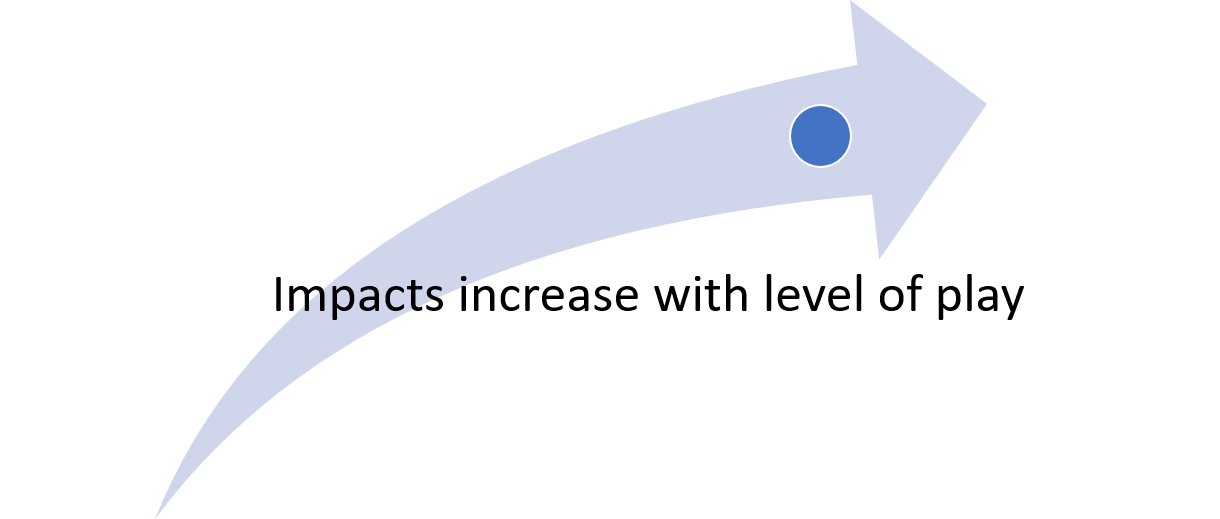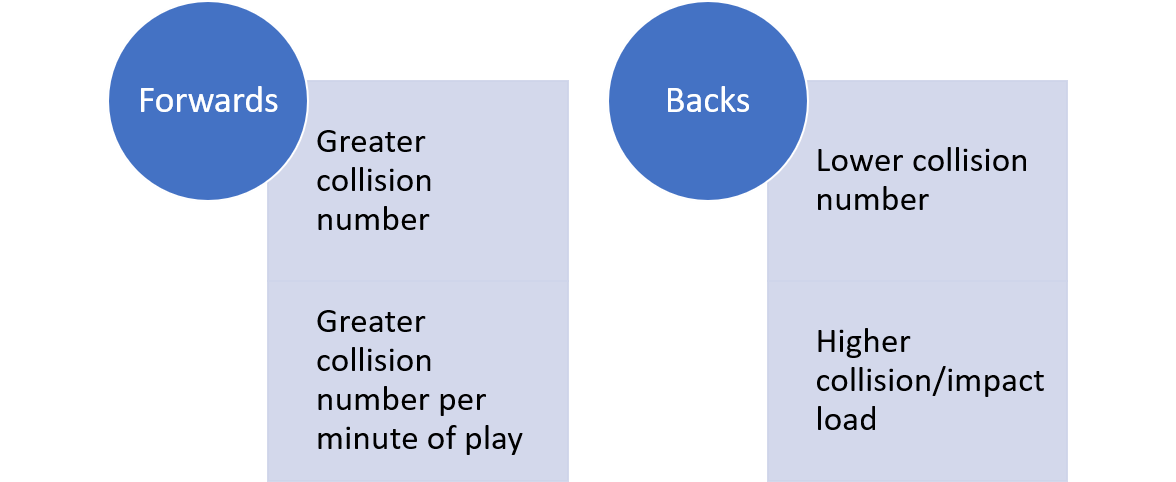Game Demands (Collision/Impact)
Figure 3. Evidence informs us that the number of impacts increases with the level of play.

Alongside locomotion demands, the extremely taxing collision or impact demands must be considered when conditioning players. Like the locomotion demands observations, both playing level and playing position can lead to differences in game demands with regards to collisions and impacts. Clarke and colleagues in 2017 looked at the game movement demands of junior, senior, and elite male and female rugby sevens players. They measured the amount of impacts per game that were greater than 10 g using GPS data. They found that the amount of impacts per game increased as the playing level went up. In male rugby sevens players, the amount of severe impacts per game was the main difference shown between playing level. This may be related to the increase in lean body mass and body mass in general as playing level increases and a more physical style of play. Female rugby sevens players showed this trend also and as playing level increased on average there were more severe impacts per game.
Macleod and colleagues in 2018 looked at measuring the frequency, rate, and magnitude of collision events for both forwards and backs during games in Pro 12 rugby. Collision events were classed as tackles or carries depending on whether the players were attacking or defending. The players played for the same club and they were divided into positional groups (prop, hooker, second row, back row and half backs, centres and back three). All four forward groups had a greater number of collisions than all three back groups and there was no significant difference in collision number between each of the forward groups. Within the backs groups, centres experienced a significantly higher number of collisions compared to half backs. Unsurprisingly, forwards also experienced a greater number of collisions per minute of match play compared to the backs. For the average load per collision, the back three experienced higher collision loads than all forward positions and the backs entered the collisions at higher speeds than the forwards. Forwards are usually closer to rucks, mauls, and set pieces meaning they don’t have to run very far for their collisions which means they may experience more collision opportunities but they do not build up a lot of speed heading into these collisions. Backs, however, are usually in a lot more space when receiving the ball or when trying to tackle. This means that while they may not experience as many collision opportunities, they have a greater chance to build up speed and thus momentum heading into a collision and the impact is greater.
Figure 4. Forwards incur more collisions during play. Backs may experience a greater collision or impact load.

Information on both the locomotion and contact demands of rugby from the research is invaluable when looking at designing conditioning-based training programmes for the players. If the coach has information about what the players do on the field during a game, then they have usable information to guide the method, the intensity, and the volume of conditioning training. The coach must however be cautious when interpreting the research and game demand information available. It has been shown how playing level and positional differences can lead to differences in game demands, but these are not the only factors that need to be considered. The age of players can have an impact, for example, there could be less of a difference in locomotion demands between forwards and back at lower age grades, possibly due to the skill level and the backs not receiving much of the ball. The style of play can be another factor which influences game demands. It is advisable for the coach to look for research and information that has been done on players that are as close in age, playing level etc. to the players that they are coaching. The game demands for international players will not be the same for club rugby players, and therefor coaches must not treat club rugby players like international players when it comes to training load. Coaches can still use information and research performed on different levels of rugby players as a guide or a bench mark for performance, but there should always be an awareness of the players that the coach is dealing with on a day to day basis and what will be best for their situation.